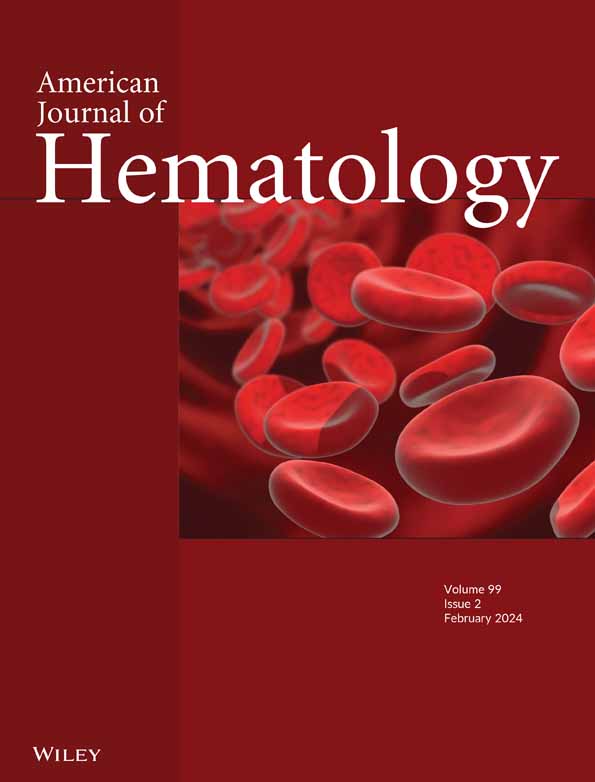Determinants of 15-Year Progression-Free Survival in Multiple Myeloma; Real-World Data From a Single Institution.
IF 10.1
1区 医学
Q1 HEMATOLOGY
引用次数: 0
Abstract
The therapeutic advances during the last two decades have rendered multiple myeloma a chronic disease and, thus, it is important to identify patient subgroups which may have extremely favorable outcomes and optimize their treatment. The current study aimed to evaluate the clinical and disease characteristics of patients with very long follow-up (minimum 15 years), to identify those with very long survival (> 15 years) and those with very long disease remissions (> 15 years) after frontline treatment diagnosed at a single center from 1994 to 2009. Among 323 consecutive, unselected patients, the calculated 15-year and 20-year cumulative survival rates were 18% and 14%, respectively. Forty-nine survived for more than 15 years. Furthermore, the calculated 15-year and 20-year cumulative PFS rates for the 323 patients were 9% and 7%, respectively; 25 (8%) patients were identified as long-term progression-free survivors. Younger age (≤ 65 years), good performance status (ECOG PS 0-1), low/intermediate risk stratification (ISS 1 or 2), absence of adverse cytogenetic abnormalities, autologous transplantation and achievement of CR to initial therapy were significantly associated with prolonged PFS. Importantly, all patients who were in complete response with negative minimal residual disease at 15 years remained at the same disease status at last follow-up. In conclusion, among patients treated with either conventional chemotherapy or with first-generation novel agents (thalidomide, bortezomib, or lenalidomide), about 15% were long-term survivors and 8% remained in long-term remission for more than 15 years without maintenance treatment.多发性骨髓瘤患者15年无进展生存期的决定因素来自单一机构的真实世界数据。
在过去的二十年中,治疗的进步使多发性骨髓瘤成为一种慢性疾病,因此,重要的是确定可能有非常有利的结果的患者亚组并优化他们的治疗。本研究旨在评估随访时间较长的患者(至少15年)的临床和疾病特征,以确定1994年至2009年在单一中心诊断的一线治疗后生存时间较长的患者(bb0 15年)和疾病缓解时间较长的患者(> 15年)。在323例连续未选择的患者中,计算的15年和20年累积生存率分别为18%和14%。其中49人存活超过15年。此外,323例患者计算的15年和20年累积PFS率分别为9%和7%;25例(8%)患者被确定为长期无进展幸存者。较年轻(≤65岁)、良好的运动状态(ECOG PS 0-1)、低/中等风险分层(ISS 1或2)、无不良细胞遗传学异常、自体移植和初始治疗达到CR与PFS延长显著相关。重要的是,所有15年时最小残留疾病为阴性的完全缓解患者在最后随访时仍处于相同的疾病状态。总之,在接受常规化疗或第一代新药(沙利度胺、硼替佐米或来那度胺)治疗的患者中,约15%是长期幸存者,8%在没有维持治疗的情况下保持15年以上的长期缓解。
本文章由计算机程序翻译,如有差异,请以英文原文为准。
求助全文
约1分钟内获得全文
求助全文
来源期刊
CiteScore
15.70
自引率
3.90%
发文量
363
审稿时长
3-6 weeks
期刊介绍:
The American Journal of Hematology offers extensive coverage of experimental and clinical aspects of blood diseases in humans and animal models. The journal publishes original contributions in both non-malignant and malignant hematological diseases, encompassing clinical and basic studies in areas such as hemostasis, thrombosis, immunology, blood banking, and stem cell biology. Clinical translational reports highlighting innovative therapeutic approaches for the diagnosis and treatment of hematological diseases are actively encouraged.The American Journal of Hematology features regular original laboratory and clinical research articles, brief research reports, critical reviews, images in hematology, as well as letters and correspondence.

 求助内容:
求助内容: 应助结果提醒方式:
应助结果提醒方式:


